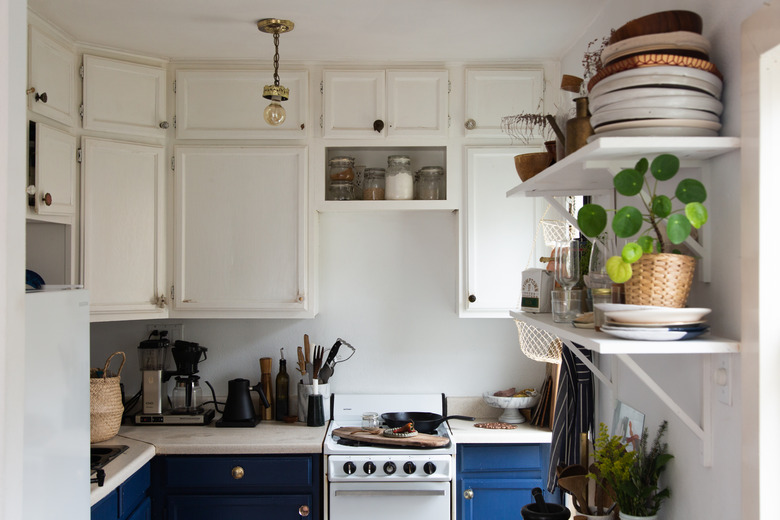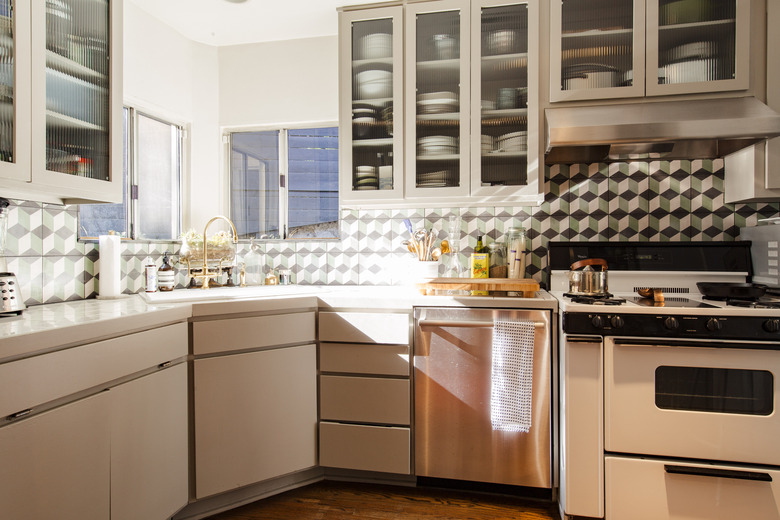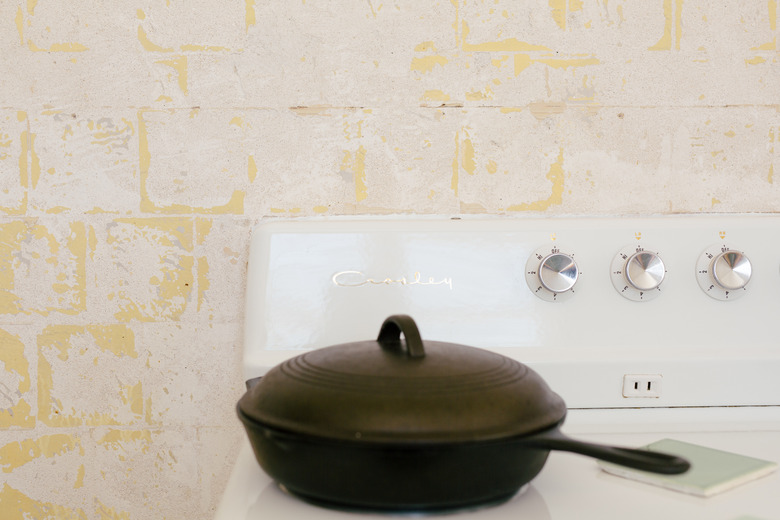How To Switch A Range Cord From 4-Prong To 3-Prong
Electric ranges, like electric clothes dryers, plug into special 240-volt outlets with either a three-prong or four-prong cord. Four prong has been the official standard since 1996, when the National Electrical Code (NEC) changed the rules about range and dryer cords and their outlets. If you install a new range or dryer outlet today, it must have four slots to accept a four-prong cord. Otherwise, you can install whichever cord you need to fit the outlet in your house.
Ranges are typically sold without cords for the simple reason that many older homes still have three-slot outlets, while almost all homes built after 2000 have four-slot outlets. Appliance manufacturers like GE and others leave it up to the consumer to get the right cord for the situation. All electric ranges will work with a three-prong or four-prong cord. Installing a cord is easy, but the wiring is slightly different for each type of cord. Switching from four prongs to three prongs or vice versa is just as easy, provided you know how to make the conversion.
Why the Change From Three Prongs to Four Prongs?
Why the Change From Three Prongs to Four Prongs?
The primary goal of the NEC is to improve electrical safety and help prevent shocks, fires and other household electrical hazards. The NEC's decision to switch from three prongs to four prongs — or three-wire to four-wire circuits — for ranges and dryers was an effort to reduce the risk of shock. If you're not an electrician, you don't really need to know why or how four-wire circuits are safer, but understanding the basics helps explain what you're doing when converting from four prongs to three prongs or from three prongs to four prongs.
The main difference between four-wire and three-wire circuits lies in the method of grounding. A ground provides a safe path for electricity to follow in the event of a short circuit or other electrical fault. Without a ground path, the metal body of a range can become electrified if there's a fault somewhere inside the appliance, and touching the range can give you a dangerous shock.
A three-wire range circuit has three wires: two hot wires carrying 120 volts each and one neutral wire that carries voltage only secondarily and also serves as a ground path for safety. A four-wire range circuit has four wires: two hot wires, a neutral wire and a separate ground wire. In this case, the neutral doesn't serve double duty as a ground wire because the circuit has a dedicated wire for that. Therein lies the additional safety of a four-wire circuit or four-prong cord. While the three-wire configuration effectively grounds fault current via its neutral wire, having a separate ground wire is more effective.
Installing an Electric Range Cord
Installing an Electric Range Cord
On the back panel of your electric range is an access cover. Behind the cover is a wiring splice box with a terminal block containing three screw terminals for the cord wires: two hots and one neutral. There's also a nearby ground screw driven into the metal body of the appliance for connecting the ground wire from a four-prong cord. If you're installing a three-prong cord, which does not have a ground wire, the ground screw on the range must be electrically connected to the neutral terminal on the terminal block, where it makes the connection to the cord's neutral wire.
The ground-to-neutral connection for three-wire hookups is typically made with a metal strap that is secured under the ground screw and the neutral screw terminal. When installing a three-prong cord, you must make sure the ground strap is secured under the neutral terminal (along with the cord's neutral wire) and the ground screw.
When installing a four-prong cord, you remove the ground strap from the neutral terminal if the range was previously configured for a three-prong cord. You can leave the strap secured under the ground screw so it doesn't get lost, but it must not connect to the neutral terminal. If you leave it in place, both the strap and the cord's ground wire will connect to the ground screw.
On some ranges, there may be a small wire (typically with white wire insulation but possibly green or green with yellow stripes) that comes out from behind the splice box and may be connected to the neutral terminal or the ground screw. If your range has this extra wire, consult the appliance manufacturer for advice. This is usually a neutral wire, but in some cases, it may be a ground, and the wiring configuration is different for each.
How to Remove a Range Cord
How to Remove a Range Cord
Warning
Before you begin removing or installing a range cord, unplug the cord from the outlet and ensure that you switch off the circuit breaker that powers the appliance.
If you're switching from a four-prong to a three-prong cord or vice versa, the first step is to remove the old cord.
- Remove the screws securing the cover on the splice box on
the back panel of the range where the cord goes in. Pull off the cover and set
it aside. - Use a screwdriver or nut driver to loosen each of the
three screw terminals on the wiring block. If the cord has ring connectors on
the ends of the wires (most do), remove the screws completely. - For four-prong cords
only, loosen and remove the ground screw to release the green ground wire. - Remove the two screws on the strain relief fitting
securing the cord to the back panel. This fitting consists of two pieces of
metal that clamp down on the cord. Remove both halves of the fitting to free
the cord. - Pull out the cord from the back of the appliance.
How to Install a Three-Prong Range Cord
How to Install a Three-Prong Range Cord
Three-prong range cords have three wires arranged side by side so that the cord has a flat shape. The wire in the middle is always the neutral wire. The two outer wires are the hot wires, and they are interchangeable. As long as you connect the center wire to the neutral terminal and connect each outer wire to one of the hot terminals — one wire per terminal — you can't get the wiring wrong. Be sure to get a strain relief fitting that matches the cord. This is a simple metal clamp that secures the cord and protects it from damage and prevents strain on the wiring connections.
- Remove the screw(s) on the access cover over the splice
box on the back of the range (if you didn't already remove it to take off the
old cord). Pull off the cover and set it aside. - Note the wiring on the terminal block. If there is a
metal strap between the ground screw and the neutral terminal on the block, you're
ready to install the cord. If there is no strap making the ground-neutral connection,
install a strap between the ground and neutral terminal following the
manufacturer's instructions. - Feed the three-prong cord into the hole or bracket in the
back panel. - Connect the center (neutral) cord wire to the center
(neutral) terminal on the terminal block using the terminal block screw.
Tighten the screw firmly with a screwdriver or nut driver. The terminal should
also have the ground strap under the terminal screw. - Connect the left cord wire to the left terminal on the
block and tighten the screw. - Connect the right cord wire to the right terminal on the
block and tighten the screw. - Double check all of the terminal screws to make sure they
are tight. Also make sure the ground screw is tightly clamping the ground strap. - Install the strain relief fitting to secure the cord to
the hole or bracket in the back panel. Fit the upper and lower halves of the
fitting over the cord and then squeeze the two halves together with the fitting's
screws. Tighten the screws alternately a little at a time so the fitting clamps
the cord evenly. Do not overtighten the fitting and damage the cord insulation. - Reinstall the access cover over the splice box. Your
range is ready to plug in.
How to Install a Four-Prong Range Cord
How to Install a Four-Prong Range Cord
Four-prong range cords have four color-coded wires: a black hot wire, a red hot wire, a white neutral wire and a green ground wire. The black and red wires are interchangeable (each one can go on either hot terminal). The white wire must go on the center (neutral) terminal. The ground wire always goes on the ground screw next to the terminal block. Be sure to buy a strain relief fitting that fits the new cord; this protects the cord from damage and is a critical part of the installation.
- Remove the screw(s) on the access cover over the splice
box on the back of the range (if you didn't already remove it to take off the
old cord). Pull off the cover and set it aside. - Note the wiring on the terminal block. If there is a
metal strap between the ground screw and the neutral terminal on the block,
loosen the neutral terminal screw and the ground screw and either rotate the
strap away from the neutral terminal (leaving it under the ground screw) or
remove it entirely. - Feed the four-prong cord into the hole or bracket in the
back panel. - Connect the white (neutral) cord wire to the center
(neutral) terminal on the terminal block using the terminal block screw.
Tighten the screw firmly with a screwdriver or nut driver. - Connect the black (hot) cord wire to the left or right terminal
on the block and tighten the screw. - Connect the red (hot) cord wire to the remaining open terminal
on the block and tighten the screw. Note: Each outer terminal must have only
one hot wire. - Connect the green (ground) cord wire to the ground screw
on the range body. - Double check all of the terminal screws and ground screw
to make sure they are tight. - Install the strain relief fitting to secure the cord to the
hole or bracket in the back panel. Fit the upper and lower halves of the
fitting over the cord and then squeeze the two halves together with the fitting's
screws. Tighten the screws alternately a little at a time so the fitting clamps
the cord evenly. Do not overtighten the fitting and damage the cord insulation. - Reinstall the access cover over the splice box. Your range is ready to plug in.
References
- GE: Range Cord 5' 50 Amp 4 Wire
- YouTube: breakerbroke23 – How to Install a Electric Dryer Cord, 3 or 4 Prong. Ground Wire Explained
- Fred's Appliance: Difference Between a 3-Prong Range Cord and a 4-Prong Range Cord
- GE: How To Install a 4-Wire Range Power Cord
- Appliance-Repair-It.com: Range Cord Installation Guide



